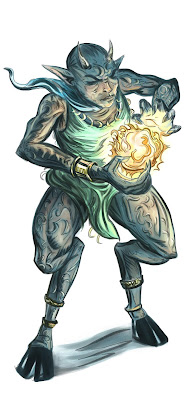Fights As...
Flipping through an old module a few days ago (G1: Against the Giants) I noticed the phrase "fights as" quite often. Female hill giants fight as ogres, the hill giant king fights as a frost giant, etc. In the days before standard rules for monster advancement, a tougher stronger monster used the stats of something related, but bigger.
This made me realize that since RPGs are really just a bunch of numbers at their core what makes them exciting is our imagining of what those numbers mean. For example, if the PCs fight a wingless drake, but the DM uses a dire tiger's stats, how would the players know? What makes the encounter exciting is the GM's description of the drake, its terrible roar, its coppery scales, its fetid breath, and its intelligent, greedy eyes. The original writers of D&D understood this and used it all the time.
The great thing about this is that you can come up with all kinds of "new" monsters and never have to buy a monster book or work up stats. Need a Lovecraftian horror from outer space? Use giant squid stats. Need a baby purple worm? Use giant eel stats. Need a wild elf barbarian? Use bugbear stats. No assembly required.
Of course, you might make a few tweaks here and there. That squid from beyond should maybe inflict unholy damage or cast darkness rather than have an ink spray. The baby purple worm should have a poison tail, but the GM could always fudge it and say young worms don't possess stingers.
This is not to knock everyone laboring long and hard on new monsters and Bestiaries. Most are pretty inventive and cool. The first thing I do when I get the latest Pathfinder is to flip to the monsters section. I love new monsters.
What this post intends is to say you can do a lot with a little, you can come up with interesting monsters at the last minute, and the best tool you have to make your game exciting is your own imagination.
This made me realize that since RPGs are really just a bunch of numbers at their core what makes them exciting is our imagining of what those numbers mean. For example, if the PCs fight a wingless drake, but the DM uses a dire tiger's stats, how would the players know? What makes the encounter exciting is the GM's description of the drake, its terrible roar, its coppery scales, its fetid breath, and its intelligent, greedy eyes. The original writers of D&D understood this and used it all the time.
The great thing about this is that you can come up with all kinds of "new" monsters and never have to buy a monster book or work up stats. Need a Lovecraftian horror from outer space? Use giant squid stats. Need a baby purple worm? Use giant eel stats. Need a wild elf barbarian? Use bugbear stats. No assembly required.
Of course, you might make a few tweaks here and there. That squid from beyond should maybe inflict unholy damage or cast darkness rather than have an ink spray. The baby purple worm should have a poison tail, but the GM could always fudge it and say young worms don't possess stingers.
This is not to knock everyone laboring long and hard on new monsters and Bestiaries. Most are pretty inventive and cool. The first thing I do when I get the latest Pathfinder is to flip to the monsters section. I love new monsters.
What this post intends is to say you can do a lot with a little, you can come up with interesting monsters at the last minute, and the best tool you have to make your game exciting is your own imagination.


Comments
Post a Comment